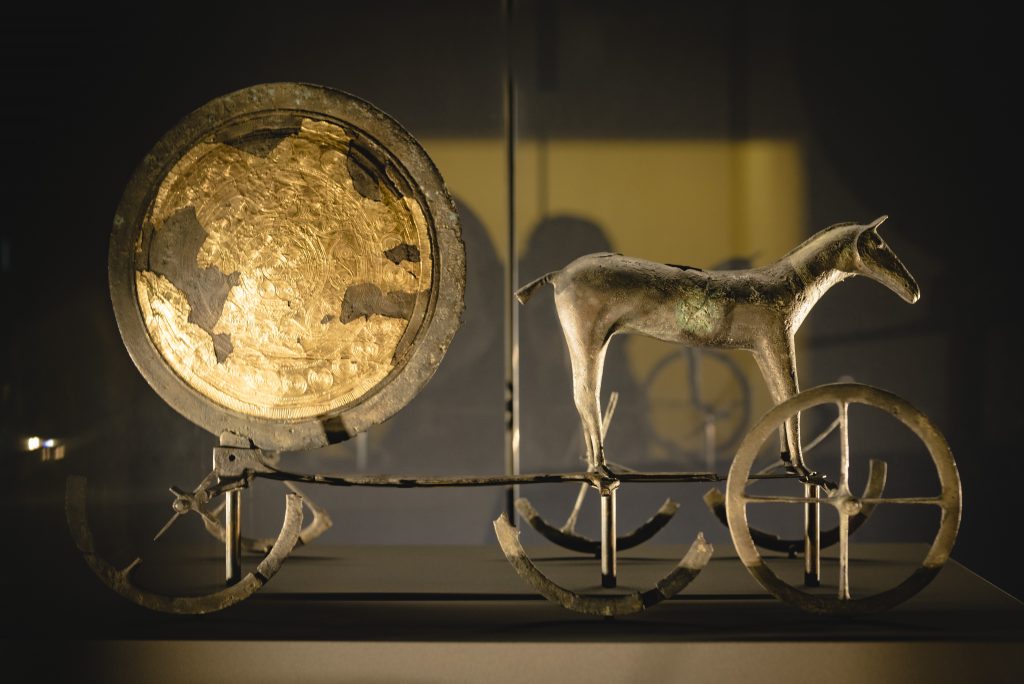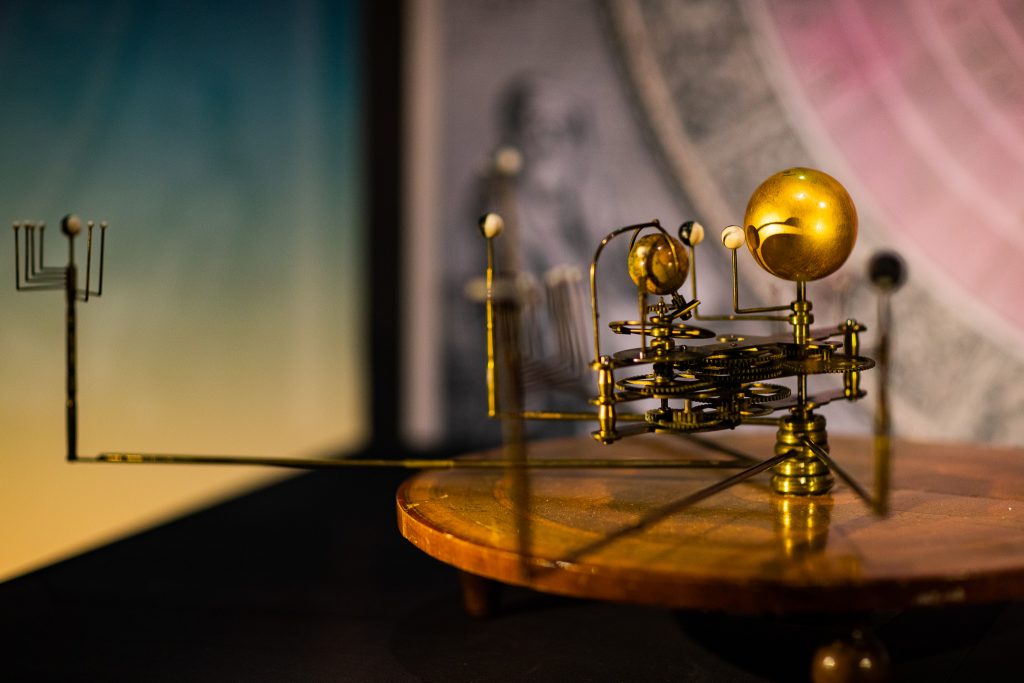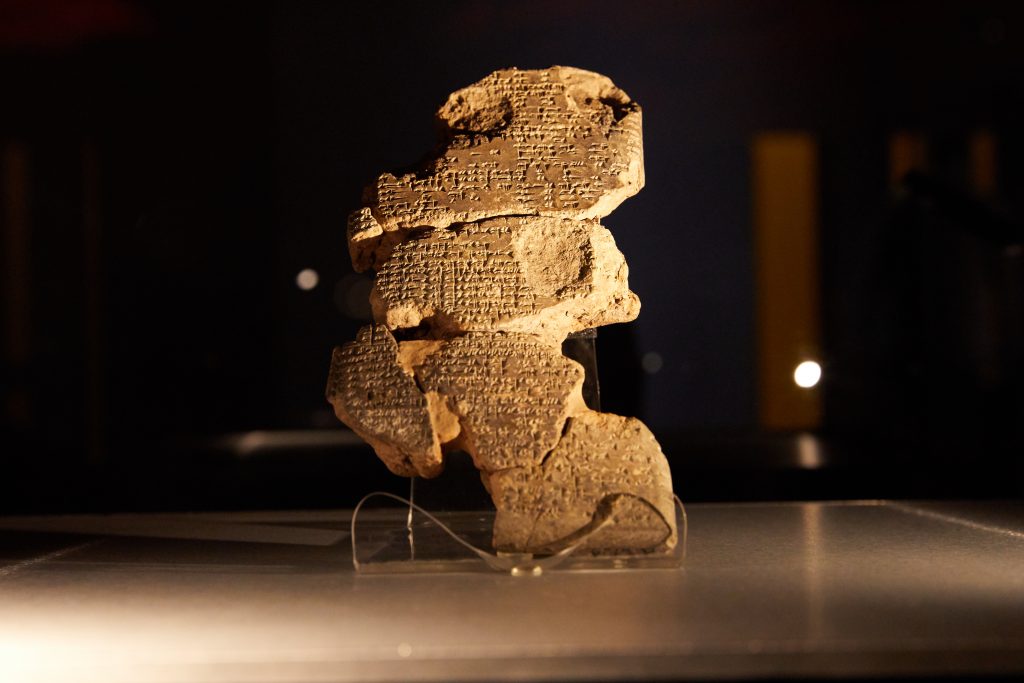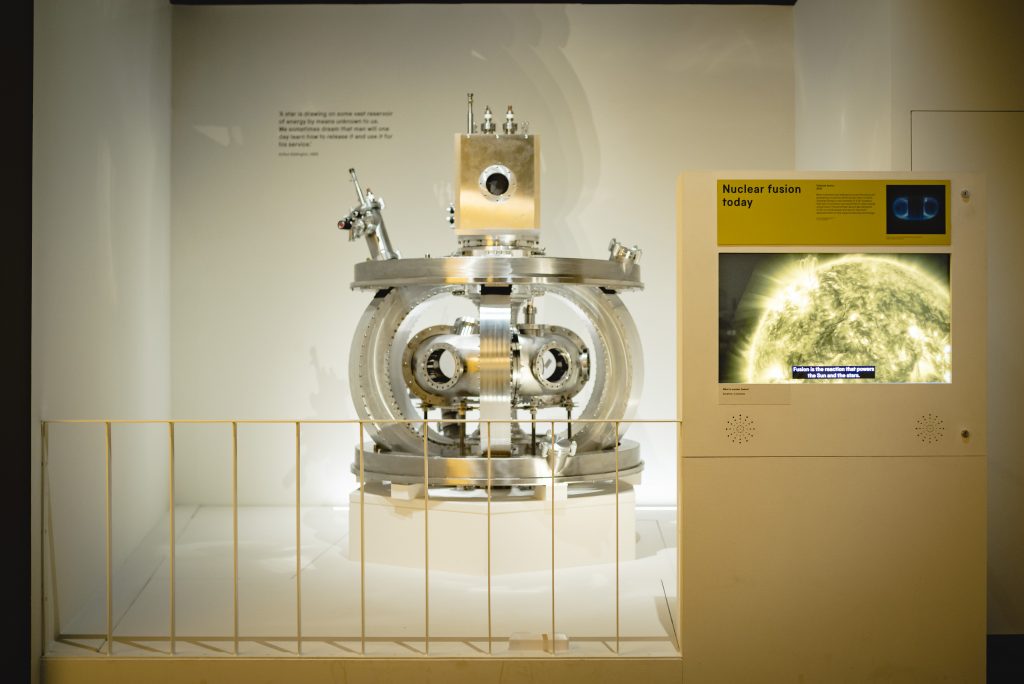Please note: The Sun exhibition ended on 4 November 2020. To find out what exhibitions and activities are open today, visit our What’s On section.
While some of these beliefs have been disproved, they offer a fascinating insight into humankind’s relationship with its nearest star. Here we take a look at five things humans have believed about the Sun – and how true they are.
a norse horse, of course
Bronze Age Norse civilisations believed that the sun was drawn through the sky on a chariot pulled by a divine horse, a belief that can be illustrated by the Sun Chariot discovered in the Trundholm Mose bog in northwestern Zealand, and dated to around 1400 BCE. One side of the disc is gilded, to represent the sun during the daytime, while the other is left dark to represent what is presented to Earth as the Sun returns from West to East during the night time.
The sun chariot wasn’t the only vehicle believed to have helped the Sun on its journey across the sky. Across Scandinavia, drawings can be found of the Sun being carried by a ship or helped by fish and snakes.

See it in The Sun: A replica of the Trundholm Sun Chariot and three pieces of an ancient golden sun ship dating from between 1400 BCE and 1100BCE are the first objects that visitors to The Sun will see. A golden cup with horse head handles, a bronze razor with an image of a sun ship and a bronze belt plate with Sun symbols are also in the first part of the exhibition, where you can watch a short video that more fully explains Nordic beliefs about the journey of the Sun.
Copernicus and the movement of the planets
One of the most famous beliefs about the Sun and the planets was that they orbited the Earth, which was placed at the centre of the Universe. This belief went back to Ancient Greek times, when scientists including Ptolemy proposed that the Earth was the stable centre of the universe around which everything else revolved. The principle was accepted for centuries, and was adopted by the Catholic Church as being consistent with what was written in the bible.
Polish scientist Nicolaus Copernicus was the first to suggest a feasible alternative theory – that the Earth was not at the centre of the universe, but that the Sun was possibly closer to it, and that the planets orbited the Sun, not the Earth. Copernicus finished his book, On The Revolutions of the Heavenly Spheres, in 1532, although it wasn’t published until 1543, just two months before Copernicus died.
A savvy printer added a note suggesting the book’s theory wasn’t really true, which prevented the Church from immediately denouncing it as heretical, although On The Revolutions of the Heavenly Spheres was eventually banned by the Catholic Church in 1616. It was also denounced by religious leader Martin Luther.

See it in The Sun: A facsimile of On The Revolutions of the Heavenly Orbs is displayed alongside two stunning orreries, mechanical devices used to demonstrate the movement of planets around the Sun, and a contrasting Earth-centred model that was made in Germany in the 1500s.
In sickness and in health
Apollo was the Greek god of the Sun, and also the god of healing, and for this reason apothecary shops were often marked by signs showing Apollo in the form of the Sun. Actually this wasn’t an incorrect belief- for instance in the 1880s scientists discovered that UV light can kill the bacteria that cause tuberculosis. This led to treatments including heliotherapy where patients suffering from TB were wheeled outside in specially-designed carriages. If the sun wasn’t shining, a Finsen lamp would create artificial sunlight for patients.
Not all beliefs about the healing power of the sun were right, however – John Harvey Kellogg, doctor and cereal magnate, invented an electric light bath for use in his sanatorium. Kellogg believed that heat from incandescent light bulbs drew blood away from sick organs, a theory which was never proved.
As we know now, the Sun can also have a harmful effect on health, particularly on the skin. While posters in the 1930s advertised sunny seaside destinations, later in the 20th century health campaigns turned their focus on the dangers of too much time in the sun, including the increased risk of skin cancer.

See it in The Sun: An 18th Century apothecary’s shop sign marks the start of the ‘Sunshine and Health’ section of the exhibition, where you can see a child’s spinal carriage and heliotherapy outfit alongside an example of Kellogg’s less successful light bath. Objects demonstrating our growing obsession with sunbathing contrast with hard-hitting health campaign posters bearing mottos including ‘Fry Now, Pay Later’.
What are sun spots?
When astronomers first observed dark spots on the Sun they disagreed about what was causing them – some believed it was because the Sun was volcanic, like the Earth, while others thought that sunspots were caused by the planets’ orbit around the Sun. We now know that sunspots are created by cooler areas on the sun in a region called the photosphere, which show up as darker spots. Sunspots are an indicator of intense magnetic activity which can be released as solar flares and big storms.

See it in The Sun: One of the earliest known references to what may be features on the Sun can be seen on the Babylonian tablet, on loan from the British Museum, in the fourth section of the exhibition: Observing the Sun. Sunspots remained fascinating for scientists including Galileo Galilei and James Nasmyth, whose stories are also told in The Sun.
Everlasting power from the Sun
A more recent belief is that recreating the nuclear fusion reactions that take place within the sun could generate limitless energy for humankind. Nuclear fusion is a process that happens deep inside the sun, where atoms are fused together creating enormous amounts of energy, which is then released as light. These 1958 newspaper articles talked about scientists successfully creating nuclear fusion – however it later turned out that it wasn’t a success after all. Despite this, scientists still believe that nuclear fusion can be achieved and can help us move towards a carbon-free future.

See it in The Sun: The attempts in 1958 to build a nuclear fusion reactor ended in embarrassment when British scientists announced their “success” to the press too soon. See press cuttings from the time in the exhibition, alongside more successful recent attempts, including this impressive prototype machine created by Tokomak Energy to combine powerful magnetic fields with high temperature superconductors to create fusion.